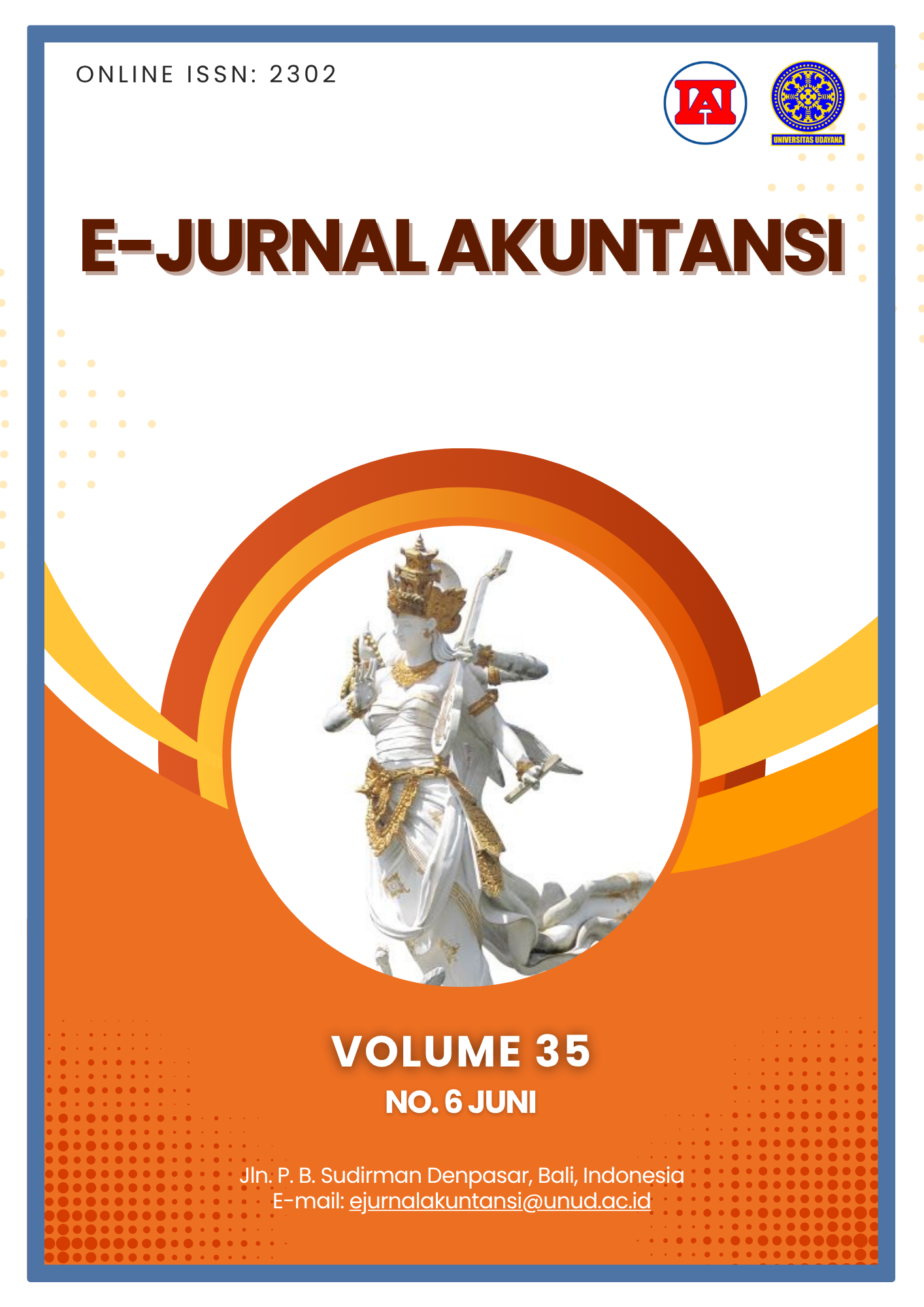Time Budget Pressure and Individual Factors as Triggers of Dysfunctional Audit Behavior in Government Auditors
Abstract
The suboptimal role of Indonesia's Government Internal Control System in enhancing state financial accountability has prompted this study to analyze factors influencing dysfunctional audit behavior among government auditors. This quantitative research utilized data from 100 respondents collected through questionnaires and analyzed using PLS-SEM. The findings reveal that: (1) time budget pressure increases dysfunctional behavior; (2) independence and religiosity decrease dysfunctional audit behavior; (3) male auditors demonstrate a higher propensity for dysfunctional audit behavior; and (4) professional competence shows no effect. These results underscore the importance of workload management, strengthened independence, and integration of ethical-religious values in preventing dysfunctional audit practices.
Keywords: Dysfunctional; Audit; Religiosity; Gender.
Downloads
References
Al-Khalvah, A. H. M. (1994). Religiosity in Islam as a Protective Mechanism against Criminal Temptation. The American Journal of Islamic Social Sciences, 11. https://doi.org/doi.org/10.35632/ajis.v11i1.2451
Anita, R., Nanda, S. T., Zenita, R., & Abdillah, M. R. (2018). Locus of Control, Penerimaan Auditor atas Dysfunctional Audit Behavior dan Intention to Quit. Jurnal Dinamika Akuntansi Dan Bisnis, 5(1), 43–54. https://doi.org/10.24815/jdab.v5i1.8623
Arens, A. A. ., Elder, R. J. ., & Beasley, M. S. . (2017). Auditing and Assurance Services. Pearson.
Badan Pemeriksa Keuangan. (2023). Laporan Hasil Pemeriksaan Atas Sistem Pengendalian Intern dan Kepatuhan terhadap Ketentuan Peraturan Perundang-undangan Badan Pusat Statistik Tahun 2023. Badan Pemeriksa Keuangan.
Balasingam, S., Arumugam, D., & Sanatova, A. (2019). Auditors Acceptance of Dysfunctional Behaviour in Kazakhstan. International Journal of Recent Technology and Engineering (IJRTE), 7(5), 134–140. www.ijrte.org
Behn, B. K., Carcello, J. V, Hermanson, D. R., Hermanson, R. H., Heape, S., Husain, A., & Nagy, T. N. (1999). Client Satisfaction and Big 6 Audit Fees*. Contemporary Accounting Research, 16(4), 587–608.
Broberg, P., Tagesson, T., Argento, D., Gyllengahm, N., & Mårtensson, O. (2017). Explaining the influence of time budget pressure on audit quality in Sweden. Journal of Management and Governance, 21(2), 331–350. https://doi.org/10.1007/s10997-016-9346-4
Croson, R., & Gneezy, U. (2009). Gender Differences in Preferences. Journal of Economic Literature, 47(2), 448–474. https://doi.org/10.1257/jel.47.2.448
Donnelly, D. P., Quirin, J. J., & O’Bryan David. (2003). Auditor Acceptance of Dysfunctional Audit Behavior: An Explanatory Model Using Auditors’ Personal Characteristics. Behavioral Research In Accounting, 15, 87–110. https://doi.org/10.2308/bria.2003.15.1.87
Ghozali, I. (2021). Aplikasi Analisis Multivariate dengan Program IBS SPSS 26 (X, Vol. 1). Badan Penerbit Universitas Diponegoro.
Hair, J. F. ., Hult, G. T. M. ., Ringle, C. M. ., & Sarstedt, Marko. (2017). A Primer on Partial Least Squares Structural Equation Modeling (PLS-SEM). Sage.
Heider, F. (1958). The Psychology of Interpersonal Relations (1st ed.). John Wiley & Sons Inc. https://doi.org/doi.org/10.4324/9780203781159
Iskandar, T., Rahmat, M. M., & Ismail, H. (2010). The Relationship Between Audit Client Satisfaction and Audit Quality Attributes: Case of Malaysian Listed Companies. International Journal of Economics and Management, 4, 155–180. https://www.researchgate.net/publication/228751113
Johari, R. J., Mohd Hairudin, N. A., & Dawood, A. K. (2022). Analysis of factors affecting dysfunctional audit behavior in Malaysia. International Journal of Ethics and Systems, 38(4), 702–719. https://doi.org/10.1108/IJOES-07-2021-0151
Khalil, S., & Nehme, R. (2023). Performance evaluations and junior auditors’ attitude to audit behavior: a gender and culture comparative study. Meditari Accountancy Research, 31(2), 239–257. https://doi.org/10.1108/MEDAR-04-2021-1285
Luthans, F. (2011). Organizational Behavior: an Evidence-Based Approach (12th ed.). McGraw.
Nehme, R., Kozah, Alc. E., & Khalil, S. (2024). Dysfunctional audit behavior: exploring the impact of longitudinal work experience and gender. Journal of Accounting and Organizational Change. https://doi.org/10.1108/JAOC-11-2023-0196
Nehme, R., Michael, A., & Haslam, J. (2022). The impact of time budget and time deadline pressures on audit behaviour: UK evidence. Meditari Accountancy Research, 30(2), 245–266. https://doi.org/10.1108/MEDAR-09-2019-0550
Otley, D. T., & Pierce, B. J. (1996). Auditor time budget pressure: Consequences and antecedents. Accounting, Auditing & Accountability Journal, 9(1), 31–58. https://doi.org/10.1108/09513579610109969
Paino, H., Smith, M., & Ismail, Z. (2012). Auditor acceptance of dysfunctional behaviour: An explanatory model using individual factors. Journal of Applied Accounting Research, 13(1), 37–55. https://doi.org/10.1108/09675421211231907
Palmer, S., Cooper, C., & Thomas, K. (2004). Creating a Balance: Managing Stress. British Library Board. www.hse.gov.uk
Prabangkara, S., & Fitriany, F. (2021). Factors that affect dysfunctional audit behaviour: A study to understand external auditor’s role as the guardians of strong and justice organizations (Goal 16 sustainable development goals). IOP Conference Series: Earth and Environmental Science, 716(1). https://doi.org/10.1088/1755-1315/716/1/012116
Pujaningrum, I., & Sabeni, A. (2012). Analisis Faktor-Faktor yang Mempengaruhi Tingkat Penerimaan Auditor atas Penyimpangan Perilaku dalam Audit (Studi Empiris pada Kantor Akuntan Publik di Semarang). Diponegoro Journal of Accounting, 1(1), 1. http://ejournal-s1.undip.ac.id/index.php/accounting
Purnamasari, P., & Amaliah, I. (2015). Fraud Prevention: Relevance to Religiosity and Spirituality in the Workplace. Procedia - Social and Behavioral Sciences, 211, 827–835. https://doi.org/10.1016/j.sbspro.2015.11.109
Robbins, S. P., Judge, T. A., & Brewad, K. E. (2018). Essentials of Organizational Behavior (14th ed.). Perason Education Inc.
Said, J., Alam, M. M., Karim, Z. A., & Johari, R. J. (2018). Integrating religiosity into fraud triangle theory: findings on Malaysian police officers. Journal of Criminological Research, Policy and Practice, 4(2), 111–123. https://doi.org/10.1108/JCRPP-09-2017-0027
Sholihin, M., & Ratmono, D. (2021). Analisis SEM-PLS dengan WarpPLS 7.0 untuk Hubungan Nonlinier dalam Penelitian Sosial dan Bisnis (1st ed). Andi.
Sofha, D., & Utomo, St. D. (2018). Keterkaitan Religiusitas, Gender, LOM, dan Persepsi Etika Penggelapan Pajak. Jurnal Ilmu Manajemen Dan Akuntansi Terapan, 9(2), 43–61.
Sososutiksno, C. (2010). Perilaku Disfungsional Akibat Tekanan Anggaran Waktu (Studi Empiris di Lingkungan Badan Pengawasan Daerah Tingkat I dan Tingkat II Propinsi Maluku. Jurnal Magister Akuntansi Universitas Diponegoro, 10(1), 89–96.
Sulistiyo, H. (2018). An Empirical Study on the Role of Auditor Independence in reducing Dysfunctional Audit Behavior of Public Accountants in Indonesia. Quality: Access to Success, 19(167), 93–97. https://www.researchgate.net/publication/329400199
Svanberg, J., & Öhman, P. (2016). Does Ethical Culture in Audit Firms Support Auditor Objectivity? Accounting in Europe, 13(1), 65–79. https://doi.org/10.1080/17449480.2016.1164324
Syam, M. A., Djaddang, S., Mulyadi, & Ghozali, I. (2020). The attributes of dysfunctional audit behavior (dab): Second order confirmatory factor analysis. International Journal of Financial Research, 11(2), 311–322. https://doi.org/10.5430/ijfr.v11n2p311
Thongchai, C., & Ussahawanitchakit, P. (2015). Audit specialization and audit success: an empirical investigation of certified public accountants (CPAs) in Thailand. 6th International Trade and Academic Research Conference (ITARC), 7, 395–407.
van Hau, N., Hai, P. T., Diep, N. N., & Giang, H. H. (2023). Determining factors and the mediating effects of work stress to dysfunctional audit behaviors among Vietnamese auditors. Quality - Access to Success, 24(193), 164–175. https://doi.org/10.47750/QAS/24.193.18
Widhiaswari, D. A. S., Wianto Putra, I. M., & Damayanti, N. N. S. R. (2021). Pengaruh Tekanan Anggaran Waktu, Locus of Control, Kompleksitas Tugas dan Turnover Intention Terhadap Perilaku Disfungsional Auditor Pada Kantor Akuntan Publik di Provinsi Bali. Jurnal Riset Akuntansi Warmadewa, 2(1), 54–59. https://doi.org/10.22225/jraw.2.1.2934.54-59
Wijayanti, D. M., Senjani, Y. P., & Farah, W. (2024). The role of Machiavellian personality, altruistic personality, religiosity, whistleblowing system, and accounting firm size in mitigating fraud intention. Journal of Financial Crime, 31(1), 119–134. https://doi.org/10.1108/JFC-02-2023-0034
Winanda, I. K. H., & Wirasedana, I. W. P. (2017). Pengaruh Tekanan Anggaran Waktu, Sifat Machiavellian dan Kompleksitas Tugas terhadap Perilaku Audit Disfungsional. E-Jurnal Akuntansi Universitas Udayana, 18(1), 500–528.
Wiyantoro, L. S., & Yuanyuan, L. (2023). Evaluating the performance of external auditor during COVID-19: The case of dysfunctional audit behaviour in Indonesia. Cogent Business and Management, 10(2). https://doi.org/10.1080/23311975.2023.2246744
Yuen, D. C. Y., Law, P. K. F., Lu, C., & Guan, J. Q. (2013). Dysfunctional auditing behaviour: Empirical evidence on auditors’ behaviour in Macau. International Journal of Accounting and Information Management, 21(3), 209–226. https://doi.org/10.1108/IJAIM-12-2012-0075
Yulianti, Chandrarin, G., & Supanto, F. (2022). Effect of ethics and professionalism on audit quality: A moderating role of dysfunctional audit behavior. Problems and Perspectives in Management, 20(3), 529–539. https://doi.org/10.21511/ppm.20(3).2022.42
Zam, D. R. P., & Rahayu, S. (2015). The Influence of Time Budget Pressure, Audit Fee and Auditor’s Independency on Audit Quality (Case Study of Public Accounting Firms in Bandung. E-Proceeding of Management, 2.
Zamzam, I., Mahdi, S. A., & Ansar, R. (2017). Pengaruh Diamond Fraud dan Tingkat Religiusitas terhadap Akademik (Studi pada Mahasiswa S-1 di Lingkungan Perguruan Tinggi se KotaTernate). Jurnal Ilmiah Akuntansi Peradaban, 3(1), 1–24.

This work is licensed under a Creative Commons Attribution-ShareAlike 4.0 International License.

















